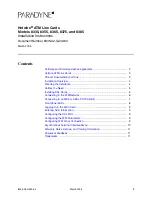
Network Time Service GPS-2-E-NTP www.buenoptic.com
7
5 NTP - Network Time Protocol
Before you learn how to setup GPS-2-E-NTP, you also should read about what NTP itself.
NTP is a common method for time synchronization over networks. It is a protocol but a very
special one. The NTP is much di
ff
erent from any of known other communication protocols. It is
because NTP does not base on the principles of synchronizing machines to each other. It is based
on the principles of having all machines get as close as possible to the UTC time provided by
GPS-2-E-NTP. How it works?
GPS-2-E-NTP forms a statistic of delays and other data necessary to calculate local client
RTC o
ff
set. Knowing time di
ff
erence the adjustment of the own RTC clock can be preceded
individually by each NTP client.
NTP works on a hierarchical model in which a small number of servers gives time to a large
number of clients. The clients on each level, or stratum, are in turn, potential servers to an even
larger number of clients on a higher numbered stratum. Stratum numbers increase from the
primary (stratum 1) servers to the lowest numbered strata at the bottom of the tree (stratum 15).
Clients can use time information from multiple servers to determine automatically the best source
of time and prevent wrong time sources from corrupting their own time.
For sure it may take several minutes (or even hours) to adjust a system time to the ultimate
degree of accuracy. There are several reasons for this. The most important one is that NTP
averages the results of several time exchanges in order to reduce the e
ff
ects of variable latency.
This may take several minutes for NTP to even reach consensus on what the average latency is.
Generally it happens in about 5-10 minutes. In addition, it often takes several adjustments for NTP
to reach a synchronization. The result is that users should not expect NTP to immediately
synchronize two clocks. The ntp date command can be used if an instant synchronization is
needed.
The enterprise of GPS-2-E-NTP
configuration includes following time sources:
•
GPS 1.5GHz radio signal (worldwide)
•
RTC internal quartz clock systems for backup































